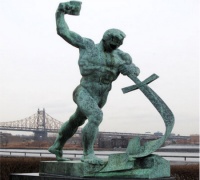Difference between revisions of "Let Us Beat Swords into Plowshares (1959)"
(Created page with "200px|thumbnail|left === A Statue for Promotion of a Peaceful Slogan Donated by the Soviet Union to the United Nations === Th...") |
|||
| Line 1: | Line 1: | ||
[[File:Let Us Beat Swords into Plowshares.jpg|200px|thumbnail|left]] | [[File:Let Us Beat Swords into Plowshares.jpg|200px|thumbnail|left]] | ||
| − | === A Statue | + | === A Soviet Statue to a Biblical Quote === |
| + | Although the communist Soviet Union was almost religiously atheistic, one of its main artists, the sculptor Evgeniy Vuchetich, used a phrase from the Book of Isaiah 2:4 as inspiration for a statue. It was Vuchetich's plan to make three statues to commemorate the World War II and the ideal of world peace. The first statue, Rodina-Mat (The Motherland Calls), was built at Stalingrad (now called Volgograd). It commemorated the Battle of Stalingrad, which was considered the definite turning point in the war against nazi-Germany. That statue is still one of the largest statues in the world. The second statue was built in Treptower Park, Berlin, which symbolized the end of World War II. 'Let us beat swords into ploughshares' would be the end of the sculpture story, to show the war was over and the world had to be rebuilt and soldiers had to be changed to workers. | ||
| − | + | === A gift to the United Nations === | |
| + | The statue of Vuchetich was donated by the Soviet Union to the United Nations in 1959. It symbolises the desire to end human conflict by converting implements of death into ones of productivity and peace. With this spirit, it depicts the figure of a man preparing to strike a sword with a hammer as he converts it to a plough blade. Given the political situation of the time, this gift was of monumental significance. With relations between the capitalist ‘West’ and communist ‘East’ growing increasingly more tense across the world, the statue represents a remarkable message of peace. In a period dominated by international politics of division, this act of cultural diplomacy displays humanity and the importance of art and soft power. | ||
[[Category: Monuments and Sculptures as Cultural Diplomacy]] | [[Category: Monuments and Sculptures as Cultural Diplomacy]] | ||
Latest revision as of 11:53, 9 January 2015
A Soviet Statue to a Biblical Quote[edit]
Although the communist Soviet Union was almost religiously atheistic, one of its main artists, the sculptor Evgeniy Vuchetich, used a phrase from the Book of Isaiah 2:4 as inspiration for a statue. It was Vuchetich's plan to make three statues to commemorate the World War II and the ideal of world peace. The first statue, Rodina-Mat (The Motherland Calls), was built at Stalingrad (now called Volgograd). It commemorated the Battle of Stalingrad, which was considered the definite turning point in the war against nazi-Germany. That statue is still one of the largest statues in the world. The second statue was built in Treptower Park, Berlin, which symbolized the end of World War II. 'Let us beat swords into ploughshares' would be the end of the sculpture story, to show the war was over and the world had to be rebuilt and soldiers had to be changed to workers.
A gift to the United Nations[edit]
The statue of Vuchetich was donated by the Soviet Union to the United Nations in 1959. It symbolises the desire to end human conflict by converting implements of death into ones of productivity and peace. With this spirit, it depicts the figure of a man preparing to strike a sword with a hammer as he converts it to a plough blade. Given the political situation of the time, this gift was of monumental significance. With relations between the capitalist ‘West’ and communist ‘East’ growing increasingly more tense across the world, the statue represents a remarkable message of peace. In a period dominated by international politics of division, this act of cultural diplomacy displays humanity and the importance of art and soft power.
